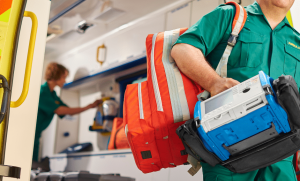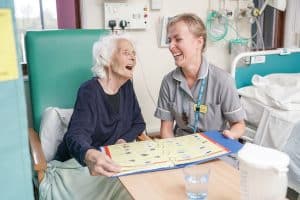Why it’s important
What we can do
How we'll measure progress
Why it’s important
In Bristol, North Somerset and South Gloucestershire, there are two hospital trusts, North Bristol NHS Trust and University Hospitals Bristol and Weston NHS Foundation Trust, both of which provide more than 100 different healthcare services to the local population.
As well as general and hospital healthcare, the two trusts provide specialist services including major trauma, neurosurgery, children’s services, burns, cardiac and cancer services.
In Bristol, North Somerset and South Gloucestershire, similar to many parts of the country, hospital healthcare services are still working through the impacts of the Covid-19 pandemic and backlog of demand.
We want to address the demand and capacity gaps across our hospital services, reducing the length of time people are waiting for appointments, tests and treatment, and supporting them while they wait.
What we can do
In 2021, the two trusts established an Acute Provider Collaborative to work together at scale to ensure the best care is provided for patients and the best support and development is provided for staff.
Some of the priority areas in our acute healthcare services include Healthy Weston 2, maternity and neonatal services, virtual wards, NHS@Home, elective and planned care, and stroke services.
Healthy Weston
The Healthy Weston 2 programme has an ambitious vision for Weston General Hospital to be a strong and sustainable hospital at the heart of the community, delivering integrated, safe and high-quality services that meets the needs of the population, now and in the future.
Maternity and Neonatal
Our Local Maternity and Neonatology System has been introduced in partnership with providers, commissioners, local authorities and Bristol, North Somerset and South Gloucestershire Maternity Voices to improve care for women, babies and their families and reduce health inequalities.
Urgent and emergency care
The performance of urgent and emergency care services in our system was impacted by the Covid-19 pandemic, and continues to be impacted due to a backlog of demand. These services are in a period of recovery and our ambition is to return to pre-pandemic levels of performance.
Virtual wards – NHS@Home
The ‘NHS@Home’ service is a joint initiative by local NHS organisations that offers hospital-level care and remote monitoring in an individual’s home, providing an alternative to hospital admission, or helping them to return home promptly following an inpatient stay. This service currently provides between 100-120 virtual ward beds, which we will continue to develop and increase, building up to 450 virtual ward beds – this capacity is equivalent to between 200 and 280 hospital beds.
Planned care
Planned, or elective care, including outpatients, cancer and diagnostics services were significantly impacted by the Covid-19 pandemic, causing backlogs of long waits for patients.
Our aims within planned care include reducing the length of time people are waiting for appointments, tests and treatment and to support people while they wait.
Stroke
Stroke is both a sudden and devastating life event and a long-term condition. It is the fourth biggest cause of death in the UK, and a leading cause of disability. Around 1,500 people in our area have a stroke every year.
Over recent years there have been significant advances in proven, highly effective methods of stroke treatment and care. In line with national guidance, and with the support of NHS England and Improvement, our stroke programme proposed a transformed stroke service in May 2023 to realise the vision that everyone in Bristol, North Somerset and South Gloucestershire will have the best opportunity to survive and thrive after suffering from a stroke.
How we’ll measure progress
Maternity and neonatal
- Reduce stillbirth, neonatal mortality, maternal death and serious brain injury during childbirth.
- Increase the number of women receiving a personalised care plan and being supported to make informed choices.
- Reduce inequalities in access and outcomes for the groups that experience the greatest inequalities.
Urgent and emergency care
These ambitions are set out in NHS England’s Delivery plan for recovering urgent and emergency care services, which includes the primary aims of:
- Improving Accident and Emergency (A&E) waiting times so that no less than 76% of patients are seen within four hours by March 2024 with further improvement in 2024/25.
- Improve category two ambulance response times to an average of 30 minutes across 2023/24, with further improvement towards pre-pandemic levels in 2024/25.
- Reduce Adult General and Acute bed occupancy to 92% or below.
- Consistently meet or exceed the 70% – two-hour urgent community response standard.
Planned care
- To eliminate waits of over 65 weeks by the end of September 2024 (except where patients choose to wait longer).
- Improve the percentage of patients needing a diagnostic test by receiving it within six weeks, with an ambition of 95% by March 2025.
- Increase the percentage of cancers diagnosed at stages 1 and 2 in line with the 75% early diagnosis ambition by 2028.
Stroke
- To ensure fewer people die from stroke each year.
- To ensure expert care is provided in the hospital, home and community.
- To ensure services are high quality and sustainable for the future.
This page provides an overview. To read about our plans in detail, take a look at the full Joint Forward Plan 2024-2029.
Joint Forward Plan 2024-2029
In this video, find out more about the ‘NHS@Home’ service, a joint initiative by local NHS organisations that offers hospital-level care and remote monitoring in an individual’s home.


